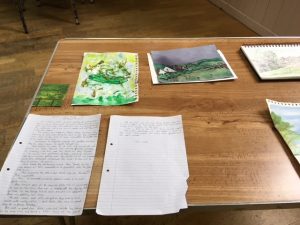This Week’s Bit of String: Faux cave paintings and hilltop views
“So what sorts of things do you write?”
Do you dread this question like I do? I’ve learned to summarise individual novels I’m writing, to develop extra-short hooks and elevator pitches. But describing my entire work, from plays to novels to flash fiction, from speculative fiction to mythology-based to contemporary settings—that’s hard.
I find myself saying, “Oh, I sort of focus on people, family relationships… life, really.”

Last Friday I joined an Art-Making Walk around the nearby town of Wotton-Under-Edge, kindly invited by the sculptor Martin Clarke, co-chair of Under the Edge Arts. Three miles in the hills, 6 stops along the way. At each stop, participants got fifteen minutes to create a piece of art.
The walkers were primarily artists, rendering scenes in pencil or paint, a couple venturing into brief verse. The first person I met was local artist Nicky Hill, who’s come out with her own illustrated children’s book boasting loads of vibrant animal characters. Check out her page to see her wonderful paintings.
For this event, I didn’t trust my brain to kick into gear six separate times inventing new scenarios for each location. So I’d invented a character, devised some backstory, and brought her along with me. It would be easier, surely, to make each stop an episode in her story.

Our first location was a windy hill crowned by a fenced cluster of trees—the originals were planted to commemorate Waterloo. We all found those first fifteen minutes too quick. For me, I barely got my characters started. But the limitations forced us to be efficient.
En route to the next stop, an older lady with a felt flower on her hat posed The Question to me. I embellished my standard answer with, “Some of my stories are more far-fetched than others.”

“Well, people are quite far-fetched,” she observed. “So of course their stories will be.”
Clearly I was in the right sort of crowd.
The second stop was a quarry, one of the only sites I’d seen before. Quarry visitors, probably youths, had used charred sticks to decorate the rock face, not just with the usual pentagrams and melodramatic song lyrics, but also with cave painting-style art. I pictured one loner, maybe a somewhat dorky teen separating herself from the pack to create them. That previously gained image was instrumental in forming my character ahead of time.

We hiked through the woods, surrounded by wild garlic blooms like fallen stars, to our third site. That’s where the fifteen-minute stops, surprisingly, started to get too long. I would jot down the bare bones of my character’s encounter or revelation for that setting, and have a few minutes left, so I’d keep waffling, wishing instead it was enough time to properly edit what I’d done.
The third stop was also where I met Edna. She was perhaps the eldest of our group, with the most difficulty walking—which only proved she was the most determined. She was very self-critical, but I liked her painting of the forest trees; their straight dark trunks criss-crossed with dashes of green leaves.

“I like how you captured the haphazardness of it,” I said.
She was pleased. “It’s encouraging when someone recognises what I’m trying to do. And it is haphazard, the springtime, isn’t it? That’s a good word. I think it’s absolutely delicious, all these greens.”
Delicious. I thought she’d hit on rather a good word, too. We journeyed to a new hillside lookout for our fourth stop, above a slope still bearing the terraces where monks tended vineyards centuries ago. Now, velvety-looking black cows and calves amble there.

One group member was primarily a photographer. I asked her how she got on at this stop. “Well,” she replied, “We’ve already done hilltop views, so I decided to take pictures of snails on cowpats, since it’s not something we usually think of.”
Makes sense to me.

Our fifth stop was a fine stone home with gardens in ‘shelves,’ as its artist owner described it. I sat with Edna and she asked, “What’s your story about? Is it sad?”
“It’s got sad bits, but it’s not all sad. It’s about life, you know?”
“Yeah.” The old woman nodded wisely. “It’s shit, isn’t it?”
I thought I must have misheard, but she clarified. “I mean, even if you’re filthy rich, I reckon life is a bit shit.”
There’s an excuse for “dark” writing, if anyone needs one.

Our final stop brought us to a picnicking area with neighbouring ponies sulky for attention. My character’s journey ended with the walk. I’d thought of a pivotal moment for each stop, taking my protagonist from preschool, to teen years (at the Quarry, of course), to university, engagement, the failing health of a parent, and then motherhood. The story might not be worth polishing, but it did make a complete first draft with a few salvageable parts.

I’d like to try the same sort of thing with maybe a better backstory or character; visiting select locations to represent different points in the plot. It’s a useful device, and I recommend it.
The writing, in the end, was rather like how we’d described people and spring and life throughout the day: sometimes far-fetched, sometimes haphazard and sad, and sometimes, yes, a bit shit. It’s not just me, is it?